Business Strategy in the Telecommunication Sector (UK): A Case Study of Vodafone UK
VerifiedAdded on 2024/05/29
|17
|4403
|89
AI Summary
This report examines the business strategy of Vodafone UK, a leading mobile network operator in the UK. It analyzes the company's external and internal environments using PESTEL, Ansoff's growth vector matrix, VRIO/VRIN, and Porter's five forces model. The report also interprets Vodafone UK's strategic direction using Bowman's strategy clock model, highlighting the company's strengths, weaknesses, opportunities, and threats. The analysis provides insights into the competitive landscape of the UK telecommunication sector and Vodafone UK's strategic positioning within it.
Contribute Materials
Your contribution can guide someone’s learning journey. Share your
documents today.
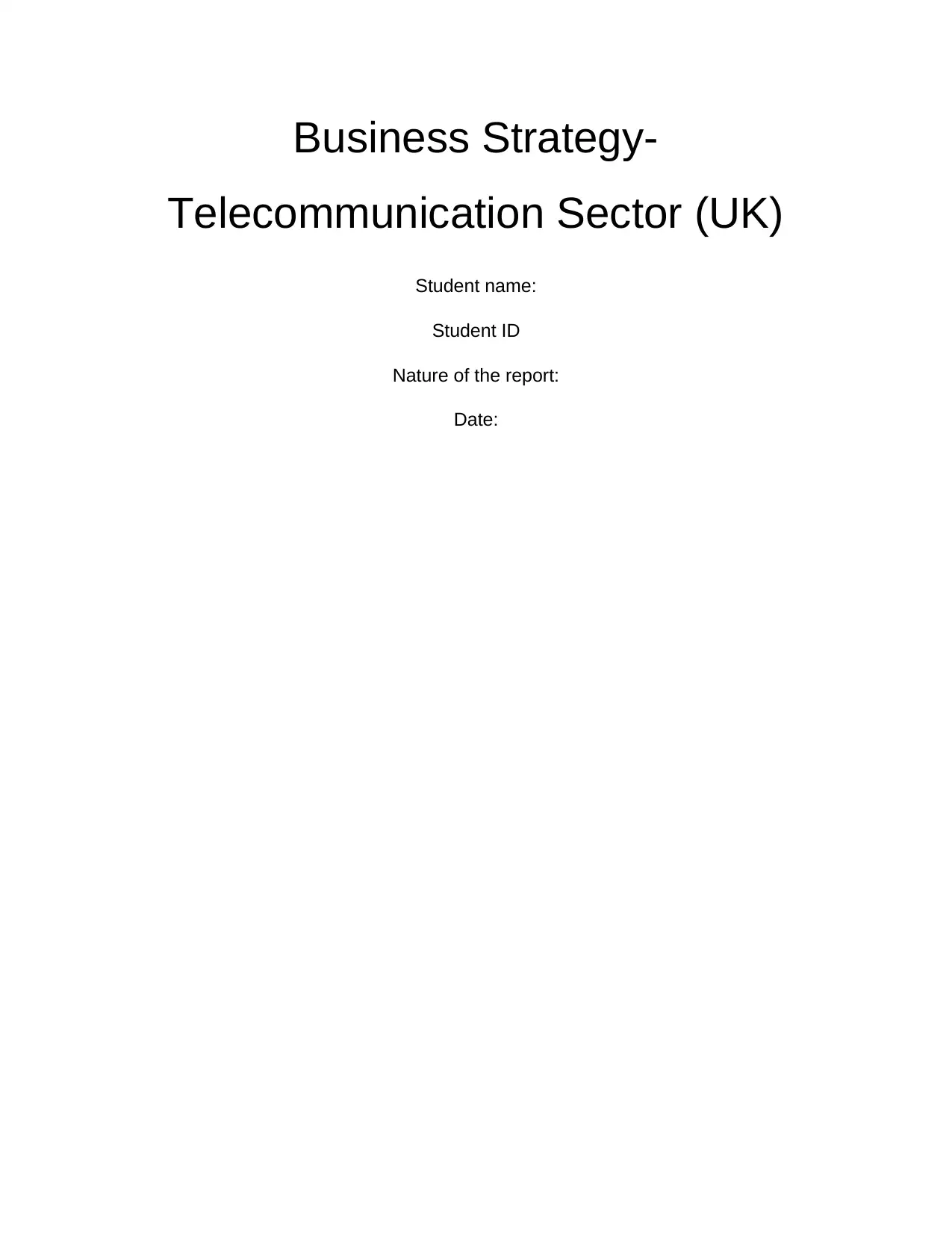
Business Strategy-
Telecommunication Sector (UK)
Student name:
Student ID
Nature of the report:
Date:
Telecommunication Sector (UK)
Student name:
Student ID
Nature of the report:
Date:
Secure Best Marks with AI Grader
Need help grading? Try our AI Grader for instant feedback on your assignments.
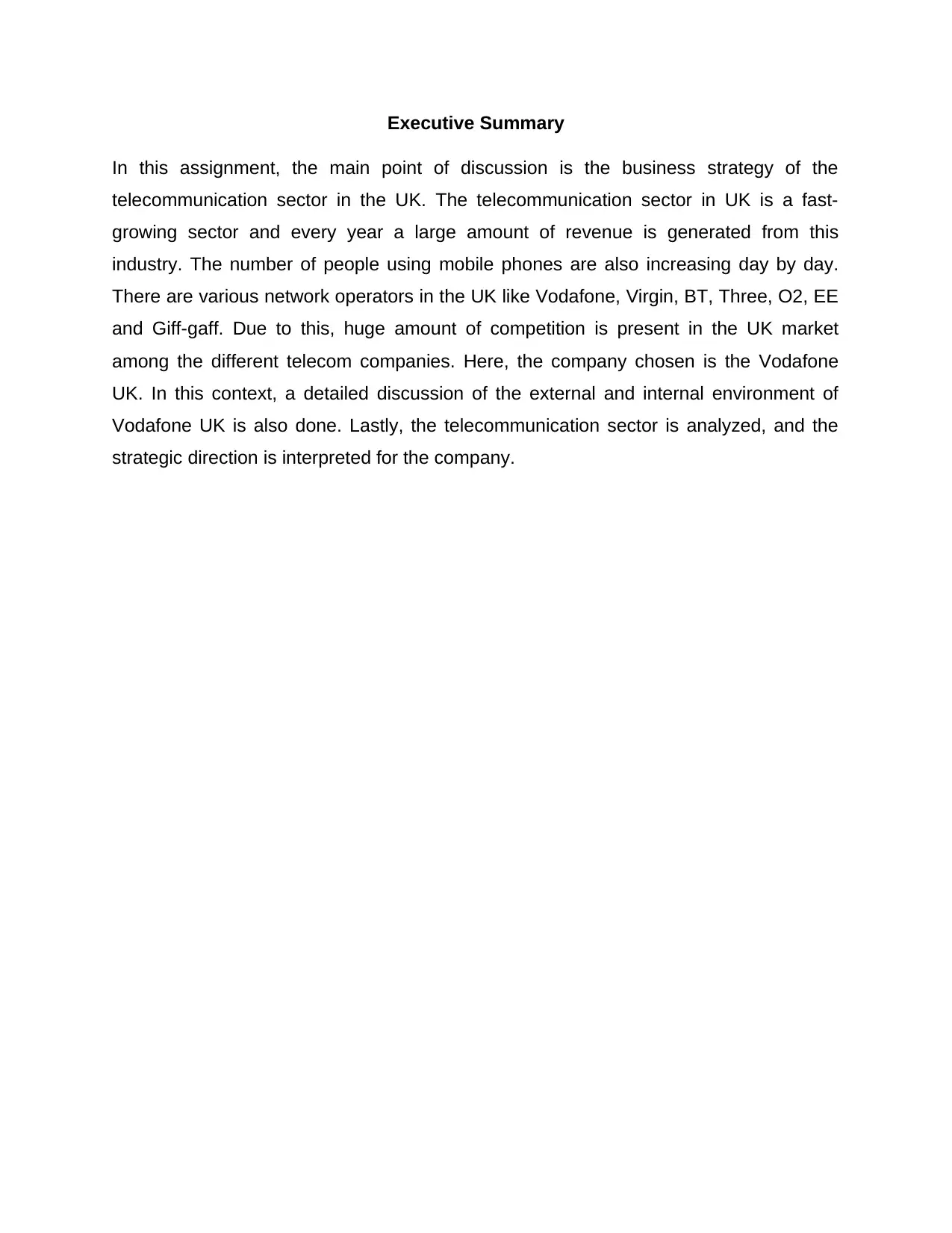
Executive Summary
In this assignment, the main point of discussion is the business strategy of the
telecommunication sector in the UK. The telecommunication sector in UK is a fast-
growing sector and every year a large amount of revenue is generated from this
industry. The number of people using mobile phones are also increasing day by day.
There are various network operators in the UK like Vodafone, Virgin, BT, Three, O2, EE
and Giff-gaff. Due to this, huge amount of competition is present in the UK market
among the different telecom companies. Here, the company chosen is the Vodafone
UK. In this context, a detailed discussion of the external and internal environment of
Vodafone UK is also done. Lastly, the telecommunication sector is analyzed, and the
strategic direction is interpreted for the company.
In this assignment, the main point of discussion is the business strategy of the
telecommunication sector in the UK. The telecommunication sector in UK is a fast-
growing sector and every year a large amount of revenue is generated from this
industry. The number of people using mobile phones are also increasing day by day.
There are various network operators in the UK like Vodafone, Virgin, BT, Three, O2, EE
and Giff-gaff. Due to this, huge amount of competition is present in the UK market
among the different telecom companies. Here, the company chosen is the Vodafone
UK. In this context, a detailed discussion of the external and internal environment of
Vodafone UK is also done. Lastly, the telecommunication sector is analyzed, and the
strategic direction is interpreted for the company.
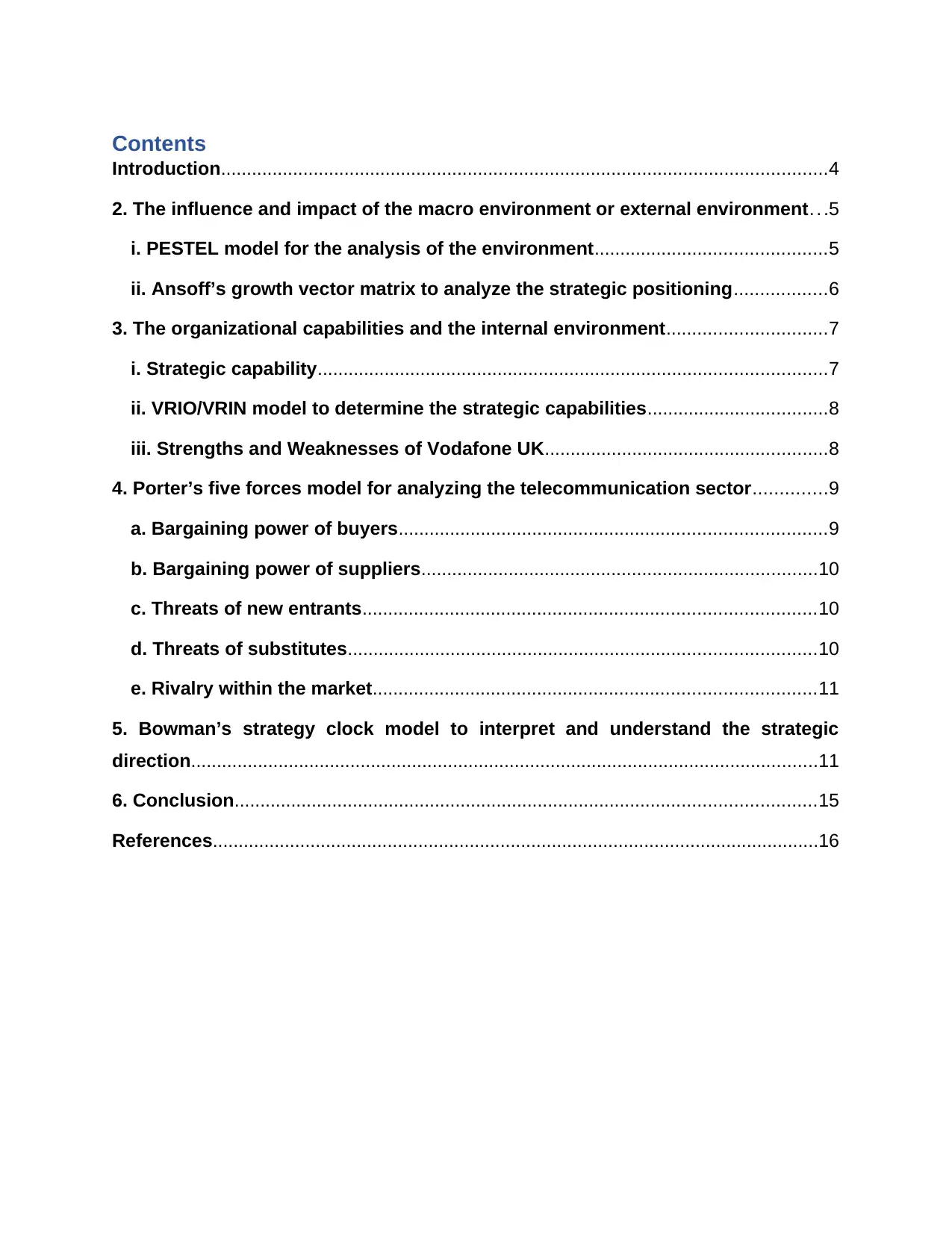
Contents
Introduction......................................................................................................................4
2. The influence and impact of the macro environment or external environment. . .5
i. PESTEL model for the analysis of the environment.............................................5
ii. Ansoff’s growth vector matrix to analyze the strategic positioning..................6
3. The organizational capabilities and the internal environment...............................7
i. Strategic capability...................................................................................................7
ii. VRIO/VRIN model to determine the strategic capabilities...................................8
iii. Strengths and Weaknesses of Vodafone UK.......................................................8
4. Porter’s five forces model for analyzing the telecommunication sector..............9
a. Bargaining power of buyers...................................................................................9
b. Bargaining power of suppliers.............................................................................10
c. Threats of new entrants........................................................................................10
d. Threats of substitutes...........................................................................................10
e. Rivalry within the market......................................................................................11
5. Bowman’s strategy clock model to interpret and understand the strategic
direction..........................................................................................................................11
6. Conclusion.................................................................................................................15
References......................................................................................................................16
Introduction......................................................................................................................4
2. The influence and impact of the macro environment or external environment. . .5
i. PESTEL model for the analysis of the environment.............................................5
ii. Ansoff’s growth vector matrix to analyze the strategic positioning..................6
3. The organizational capabilities and the internal environment...............................7
i. Strategic capability...................................................................................................7
ii. VRIO/VRIN model to determine the strategic capabilities...................................8
iii. Strengths and Weaknesses of Vodafone UK.......................................................8
4. Porter’s five forces model for analyzing the telecommunication sector..............9
a. Bargaining power of buyers...................................................................................9
b. Bargaining power of suppliers.............................................................................10
c. Threats of new entrants........................................................................................10
d. Threats of substitutes...........................................................................................10
e. Rivalry within the market......................................................................................11
5. Bowman’s strategy clock model to interpret and understand the strategic
direction..........................................................................................................................11
6. Conclusion.................................................................................................................15
References......................................................................................................................16
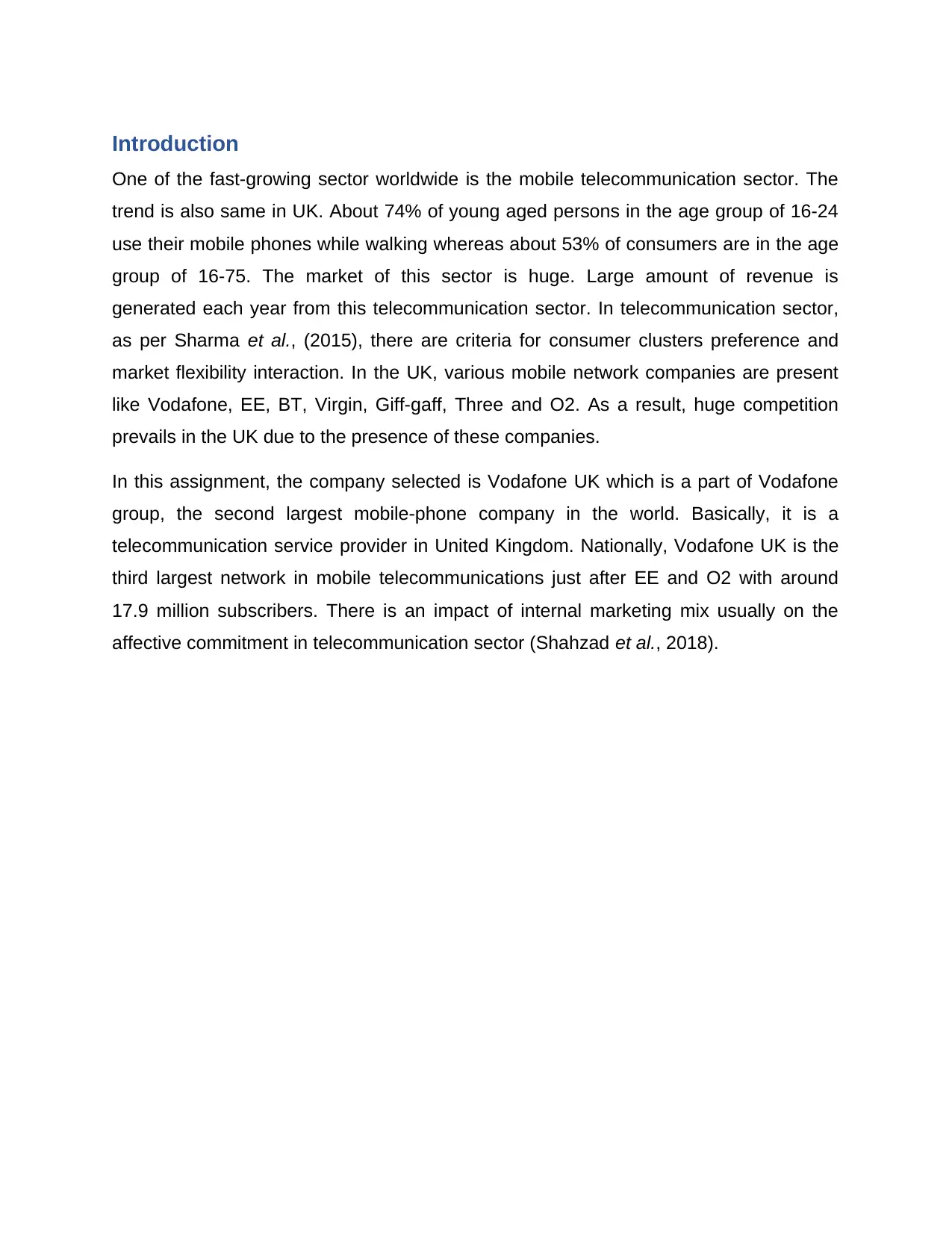
Introduction
One of the fast-growing sector worldwide is the mobile telecommunication sector. The
trend is also same in UK. About 74% of young aged persons in the age group of 16-24
use their mobile phones while walking whereas about 53% of consumers are in the age
group of 16-75. The market of this sector is huge. Large amount of revenue is
generated each year from this telecommunication sector. In telecommunication sector,
as per Sharma et al., (2015), there are criteria for consumer clusters preference and
market flexibility interaction. In the UK, various mobile network companies are present
like Vodafone, EE, BT, Virgin, Giff-gaff, Three and O2. As a result, huge competition
prevails in the UK due to the presence of these companies.
In this assignment, the company selected is Vodafone UK which is a part of Vodafone
group, the second largest mobile-phone company in the world. Basically, it is a
telecommunication service provider in United Kingdom. Nationally, Vodafone UK is the
third largest network in mobile telecommunications just after EE and O2 with around
17.9 million subscribers. There is an impact of internal marketing mix usually on the
affective commitment in telecommunication sector (Shahzad et al., 2018).
One of the fast-growing sector worldwide is the mobile telecommunication sector. The
trend is also same in UK. About 74% of young aged persons in the age group of 16-24
use their mobile phones while walking whereas about 53% of consumers are in the age
group of 16-75. The market of this sector is huge. Large amount of revenue is
generated each year from this telecommunication sector. In telecommunication sector,
as per Sharma et al., (2015), there are criteria for consumer clusters preference and
market flexibility interaction. In the UK, various mobile network companies are present
like Vodafone, EE, BT, Virgin, Giff-gaff, Three and O2. As a result, huge competition
prevails in the UK due to the presence of these companies.
In this assignment, the company selected is Vodafone UK which is a part of Vodafone
group, the second largest mobile-phone company in the world. Basically, it is a
telecommunication service provider in United Kingdom. Nationally, Vodafone UK is the
third largest network in mobile telecommunications just after EE and O2 with around
17.9 million subscribers. There is an impact of internal marketing mix usually on the
affective commitment in telecommunication sector (Shahzad et al., 2018).
Secure Best Marks with AI Grader
Need help grading? Try our AI Grader for instant feedback on your assignments.
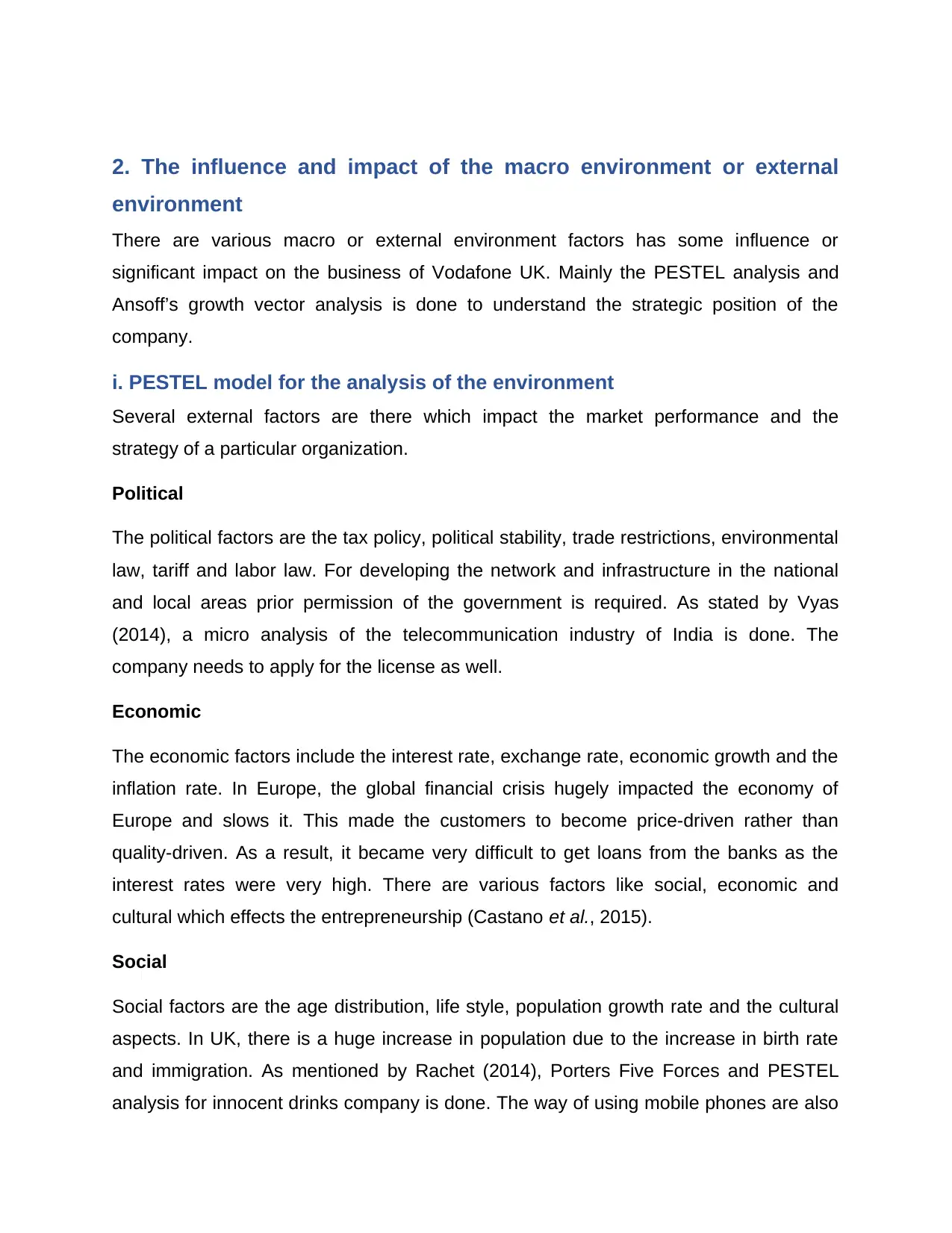
2. The influence and impact of the macro environment or external
environment
There are various macro or external environment factors has some influence or
significant impact on the business of Vodafone UK. Mainly the PESTEL analysis and
Ansoff’s growth vector analysis is done to understand the strategic position of the
company.
i. PESTEL model for the analysis of the environment
Several external factors are there which impact the market performance and the
strategy of a particular organization.
Political
The political factors are the tax policy, political stability, trade restrictions, environmental
law, tariff and labor law. For developing the network and infrastructure in the national
and local areas prior permission of the government is required. As stated by Vyas
(2014), a micro analysis of the telecommunication industry of India is done. The
company needs to apply for the license as well.
Economic
The economic factors include the interest rate, exchange rate, economic growth and the
inflation rate. In Europe, the global financial crisis hugely impacted the economy of
Europe and slows it. This made the customers to become price-driven rather than
quality-driven. As a result, it became very difficult to get loans from the banks as the
interest rates were very high. There are various factors like social, economic and
cultural which effects the entrepreneurship (Castano et al., 2015).
Social
Social factors are the age distribution, life style, population growth rate and the cultural
aspects. In UK, there is a huge increase in population due to the increase in birth rate
and immigration. As mentioned by Rachet (2014), Porters Five Forces and PESTEL
analysis for innocent drinks company is done. The way of using mobile phones are also
environment
There are various macro or external environment factors has some influence or
significant impact on the business of Vodafone UK. Mainly the PESTEL analysis and
Ansoff’s growth vector analysis is done to understand the strategic position of the
company.
i. PESTEL model for the analysis of the environment
Several external factors are there which impact the market performance and the
strategy of a particular organization.
Political
The political factors are the tax policy, political stability, trade restrictions, environmental
law, tariff and labor law. For developing the network and infrastructure in the national
and local areas prior permission of the government is required. As stated by Vyas
(2014), a micro analysis of the telecommunication industry of India is done. The
company needs to apply for the license as well.
Economic
The economic factors include the interest rate, exchange rate, economic growth and the
inflation rate. In Europe, the global financial crisis hugely impacted the economy of
Europe and slows it. This made the customers to become price-driven rather than
quality-driven. As a result, it became very difficult to get loans from the banks as the
interest rates were very high. There are various factors like social, economic and
cultural which effects the entrepreneurship (Castano et al., 2015).
Social
Social factors are the age distribution, life style, population growth rate and the cultural
aspects. In UK, there is a huge increase in population due to the increase in birth rate
and immigration. As mentioned by Rachet (2014), Porters Five Forces and PESTEL
analysis for innocent drinks company is done. The way of using mobile phones are also
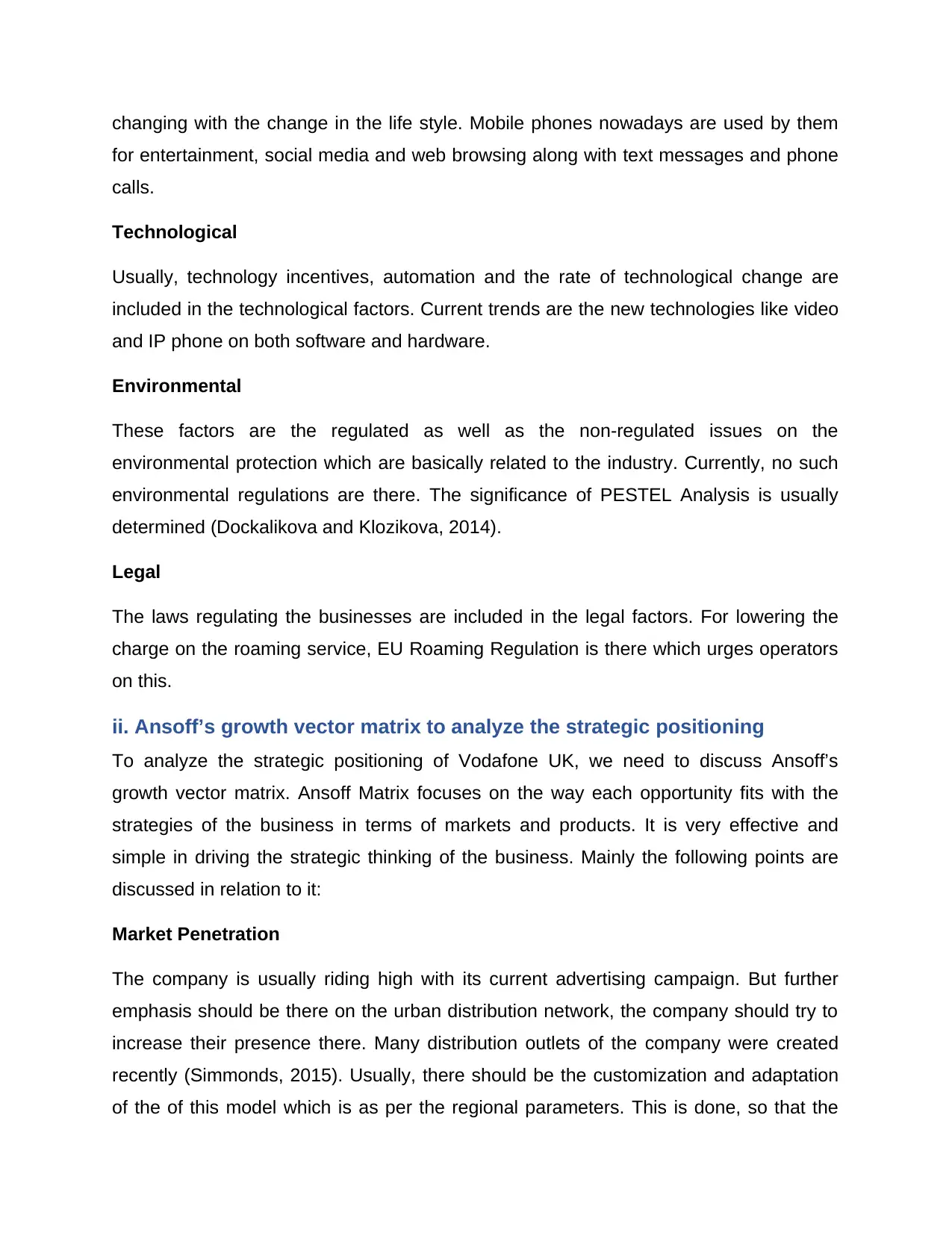
changing with the change in the life style. Mobile phones nowadays are used by them
for entertainment, social media and web browsing along with text messages and phone
calls.
Technological
Usually, technology incentives, automation and the rate of technological change are
included in the technological factors. Current trends are the new technologies like video
and IP phone on both software and hardware.
Environmental
These factors are the regulated as well as the non-regulated issues on the
environmental protection which are basically related to the industry. Currently, no such
environmental regulations are there. The significance of PESTEL Analysis is usually
determined (Dockalikova and Klozikova, 2014).
Legal
The laws regulating the businesses are included in the legal factors. For lowering the
charge on the roaming service, EU Roaming Regulation is there which urges operators
on this.
ii. Ansoff’s growth vector matrix to analyze the strategic positioning
To analyze the strategic positioning of Vodafone UK, we need to discuss Ansoff’s
growth vector matrix. Ansoff Matrix focuses on the way each opportunity fits with the
strategies of the business in terms of markets and products. It is very effective and
simple in driving the strategic thinking of the business. Mainly the following points are
discussed in relation to it:
Market Penetration
The company is usually riding high with its current advertising campaign. But further
emphasis should be there on the urban distribution network, the company should try to
increase their presence there. Many distribution outlets of the company were created
recently (Simmonds, 2015). Usually, there should be the customization and adaptation
of the of this model which is as per the regional parameters. This is done, so that the
for entertainment, social media and web browsing along with text messages and phone
calls.
Technological
Usually, technology incentives, automation and the rate of technological change are
included in the technological factors. Current trends are the new technologies like video
and IP phone on both software and hardware.
Environmental
These factors are the regulated as well as the non-regulated issues on the
environmental protection which are basically related to the industry. Currently, no such
environmental regulations are there. The significance of PESTEL Analysis is usually
determined (Dockalikova and Klozikova, 2014).
Legal
The laws regulating the businesses are included in the legal factors. For lowering the
charge on the roaming service, EU Roaming Regulation is there which urges operators
on this.
ii. Ansoff’s growth vector matrix to analyze the strategic positioning
To analyze the strategic positioning of Vodafone UK, we need to discuss Ansoff’s
growth vector matrix. Ansoff Matrix focuses on the way each opportunity fits with the
strategies of the business in terms of markets and products. It is very effective and
simple in driving the strategic thinking of the business. Mainly the following points are
discussed in relation to it:
Market Penetration
The company is usually riding high with its current advertising campaign. But further
emphasis should be there on the urban distribution network, the company should try to
increase their presence there. Many distribution outlets of the company were created
recently (Simmonds, 2015). Usually, there should be the customization and adaptation
of the of this model which is as per the regional parameters. This is done, so that the
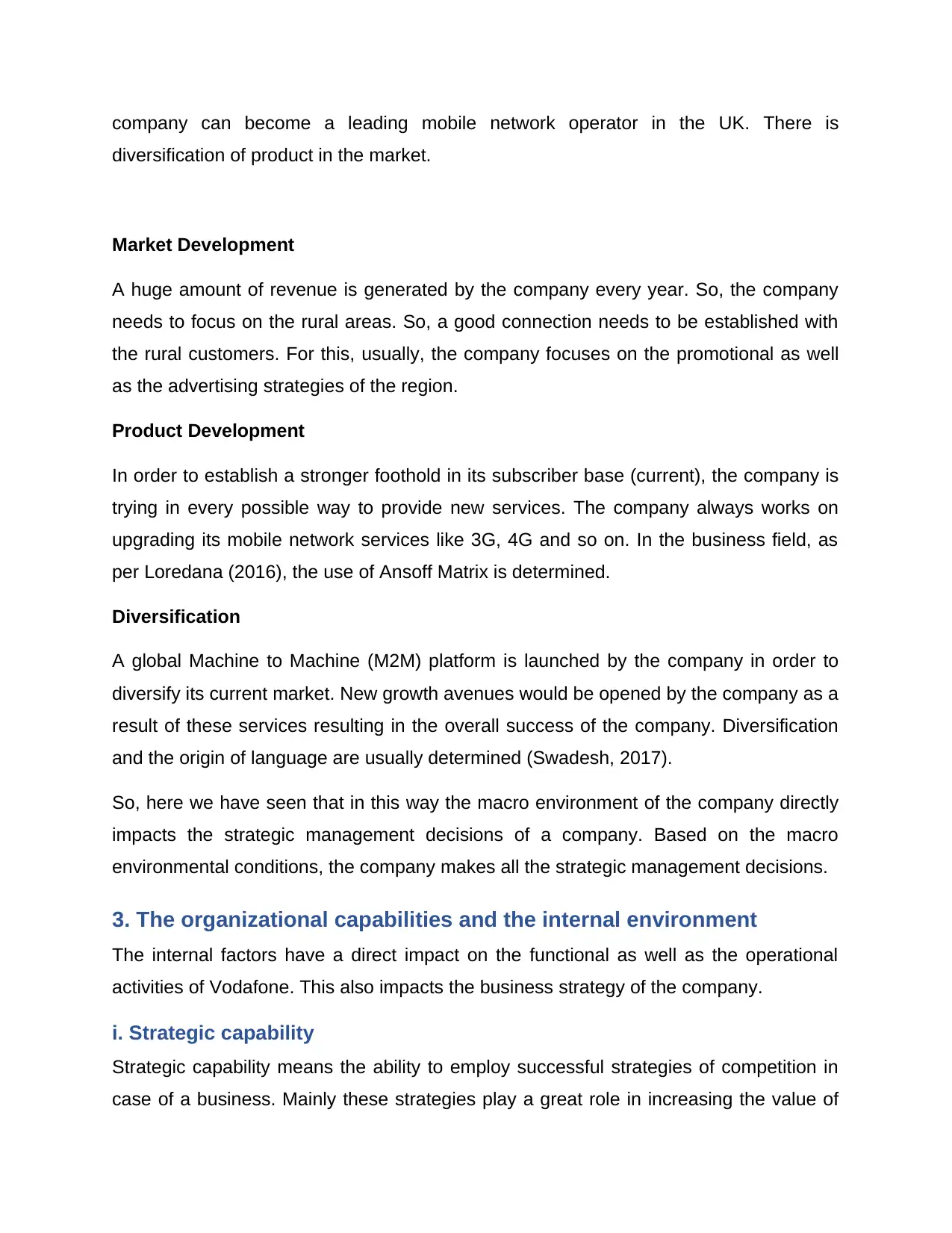
company can become a leading mobile network operator in the UK. There is
diversification of product in the market.
Market Development
A huge amount of revenue is generated by the company every year. So, the company
needs to focus on the rural areas. So, a good connection needs to be established with
the rural customers. For this, usually, the company focuses on the promotional as well
as the advertising strategies of the region.
Product Development
In order to establish a stronger foothold in its subscriber base (current), the company is
trying in every possible way to provide new services. The company always works on
upgrading its mobile network services like 3G, 4G and so on. In the business field, as
per Loredana (2016), the use of Ansoff Matrix is determined.
Diversification
A global Machine to Machine (M2M) platform is launched by the company in order to
diversify its current market. New growth avenues would be opened by the company as a
result of these services resulting in the overall success of the company. Diversification
and the origin of language are usually determined (Swadesh, 2017).
So, here we have seen that in this way the macro environment of the company directly
impacts the strategic management decisions of a company. Based on the macro
environmental conditions, the company makes all the strategic management decisions.
3. The organizational capabilities and the internal environment
The internal factors have a direct impact on the functional as well as the operational
activities of Vodafone. This also impacts the business strategy of the company.
i. Strategic capability
Strategic capability means the ability to employ successful strategies of competition in
case of a business. Mainly these strategies play a great role in increasing the value of
diversification of product in the market.
Market Development
A huge amount of revenue is generated by the company every year. So, the company
needs to focus on the rural areas. So, a good connection needs to be established with
the rural customers. For this, usually, the company focuses on the promotional as well
as the advertising strategies of the region.
Product Development
In order to establish a stronger foothold in its subscriber base (current), the company is
trying in every possible way to provide new services. The company always works on
upgrading its mobile network services like 3G, 4G and so on. In the business field, as
per Loredana (2016), the use of Ansoff Matrix is determined.
Diversification
A global Machine to Machine (M2M) platform is launched by the company in order to
diversify its current market. New growth avenues would be opened by the company as a
result of these services resulting in the overall success of the company. Diversification
and the origin of language are usually determined (Swadesh, 2017).
So, here we have seen that in this way the macro environment of the company directly
impacts the strategic management decisions of a company. Based on the macro
environmental conditions, the company makes all the strategic management decisions.
3. The organizational capabilities and the internal environment
The internal factors have a direct impact on the functional as well as the operational
activities of Vodafone. This also impacts the business strategy of the company.
i. Strategic capability
Strategic capability means the ability to employ successful strategies of competition in
case of a business. Mainly these strategies play a great role in increasing the value of
Paraphrase This Document
Need a fresh take? Get an instant paraphrase of this document with our AI Paraphraser
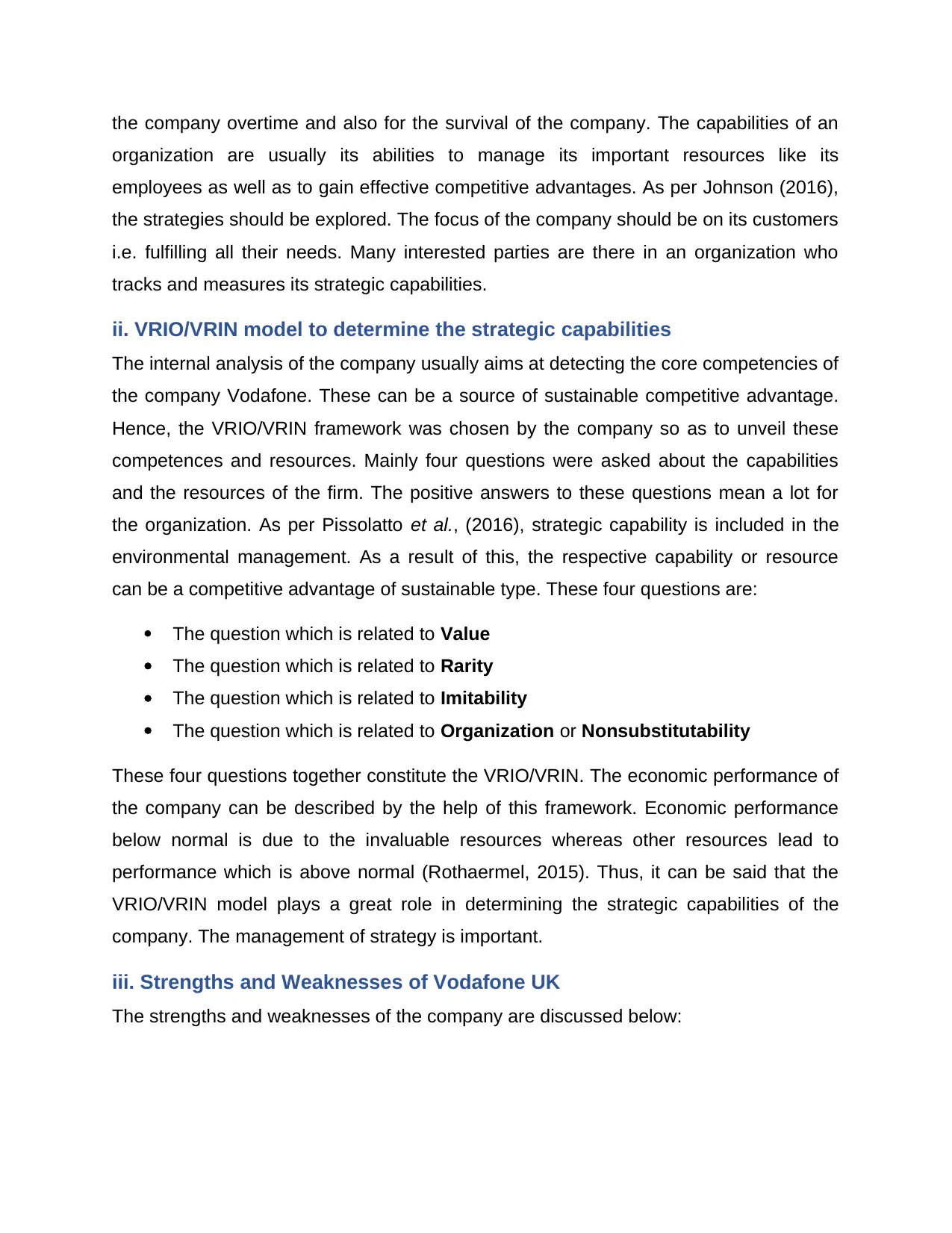
the company overtime and also for the survival of the company. The capabilities of an
organization are usually its abilities to manage its important resources like its
employees as well as to gain effective competitive advantages. As per Johnson (2016),
the strategies should be explored. The focus of the company should be on its customers
i.e. fulfilling all their needs. Many interested parties are there in an organization who
tracks and measures its strategic capabilities.
ii. VRIO/VRIN model to determine the strategic capabilities
The internal analysis of the company usually aims at detecting the core competencies of
the company Vodafone. These can be a source of sustainable competitive advantage.
Hence, the VRIO/VRIN framework was chosen by the company so as to unveil these
competences and resources. Mainly four questions were asked about the capabilities
and the resources of the firm. The positive answers to these questions mean a lot for
the organization. As per Pissolatto et al., (2016), strategic capability is included in the
environmental management. As a result of this, the respective capability or resource
can be a competitive advantage of sustainable type. These four questions are:
The question which is related to Value
The question which is related to Rarity
The question which is related to Imitability
The question which is related to Organization or Nonsubstitutability
These four questions together constitute the VRIO/VRIN. The economic performance of
the company can be described by the help of this framework. Economic performance
below normal is due to the invaluable resources whereas other resources lead to
performance which is above normal (Rothaermel, 2015). Thus, it can be said that the
VRIO/VRIN model plays a great role in determining the strategic capabilities of the
company. The management of strategy is important.
iii. Strengths and Weaknesses of Vodafone UK
The strengths and weaknesses of the company are discussed below:
organization are usually its abilities to manage its important resources like its
employees as well as to gain effective competitive advantages. As per Johnson (2016),
the strategies should be explored. The focus of the company should be on its customers
i.e. fulfilling all their needs. Many interested parties are there in an organization who
tracks and measures its strategic capabilities.
ii. VRIO/VRIN model to determine the strategic capabilities
The internal analysis of the company usually aims at detecting the core competencies of
the company Vodafone. These can be a source of sustainable competitive advantage.
Hence, the VRIO/VRIN framework was chosen by the company so as to unveil these
competences and resources. Mainly four questions were asked about the capabilities
and the resources of the firm. The positive answers to these questions mean a lot for
the organization. As per Pissolatto et al., (2016), strategic capability is included in the
environmental management. As a result of this, the respective capability or resource
can be a competitive advantage of sustainable type. These four questions are:
The question which is related to Value
The question which is related to Rarity
The question which is related to Imitability
The question which is related to Organization or Nonsubstitutability
These four questions together constitute the VRIO/VRIN. The economic performance of
the company can be described by the help of this framework. Economic performance
below normal is due to the invaluable resources whereas other resources lead to
performance which is above normal (Rothaermel, 2015). Thus, it can be said that the
VRIO/VRIN model plays a great role in determining the strategic capabilities of the
company. The management of strategy is important.
iii. Strengths and Weaknesses of Vodafone UK
The strengths and weaknesses of the company are discussed below:
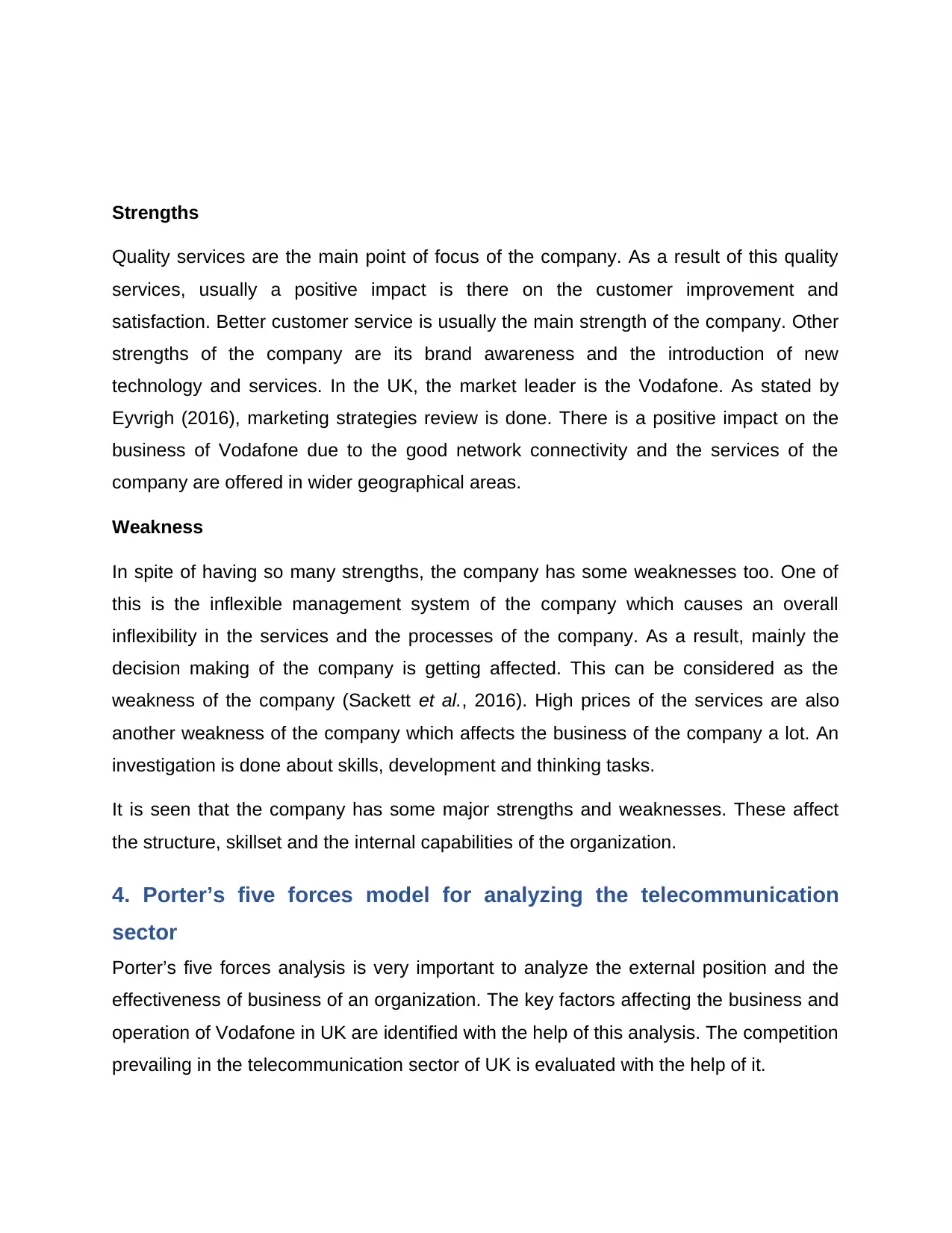
Strengths
Quality services are the main point of focus of the company. As a result of this quality
services, usually a positive impact is there on the customer improvement and
satisfaction. Better customer service is usually the main strength of the company. Other
strengths of the company are its brand awareness and the introduction of new
technology and services. In the UK, the market leader is the Vodafone. As stated by
Eyvrigh (2016), marketing strategies review is done. There is a positive impact on the
business of Vodafone due to the good network connectivity and the services of the
company are offered in wider geographical areas.
Weakness
In spite of having so many strengths, the company has some weaknesses too. One of
this is the inflexible management system of the company which causes an overall
inflexibility in the services and the processes of the company. As a result, mainly the
decision making of the company is getting affected. This can be considered as the
weakness of the company (Sackett et al., 2016). High prices of the services are also
another weakness of the company which affects the business of the company a lot. An
investigation is done about skills, development and thinking tasks.
It is seen that the company has some major strengths and weaknesses. These affect
the structure, skillset and the internal capabilities of the organization.
4. Porter’s five forces model for analyzing the telecommunication
sector
Porter’s five forces analysis is very important to analyze the external position and the
effectiveness of business of an organization. The key factors affecting the business and
operation of Vodafone in UK are identified with the help of this analysis. The competition
prevailing in the telecommunication sector of UK is evaluated with the help of it.
Quality services are the main point of focus of the company. As a result of this quality
services, usually a positive impact is there on the customer improvement and
satisfaction. Better customer service is usually the main strength of the company. Other
strengths of the company are its brand awareness and the introduction of new
technology and services. In the UK, the market leader is the Vodafone. As stated by
Eyvrigh (2016), marketing strategies review is done. There is a positive impact on the
business of Vodafone due to the good network connectivity and the services of the
company are offered in wider geographical areas.
Weakness
In spite of having so many strengths, the company has some weaknesses too. One of
this is the inflexible management system of the company which causes an overall
inflexibility in the services and the processes of the company. As a result, mainly the
decision making of the company is getting affected. This can be considered as the
weakness of the company (Sackett et al., 2016). High prices of the services are also
another weakness of the company which affects the business of the company a lot. An
investigation is done about skills, development and thinking tasks.
It is seen that the company has some major strengths and weaknesses. These affect
the structure, skillset and the internal capabilities of the organization.
4. Porter’s five forces model for analyzing the telecommunication
sector
Porter’s five forces analysis is very important to analyze the external position and the
effectiveness of business of an organization. The key factors affecting the business and
operation of Vodafone in UK are identified with the help of this analysis. The competition
prevailing in the telecommunication sector of UK is evaluated with the help of it.
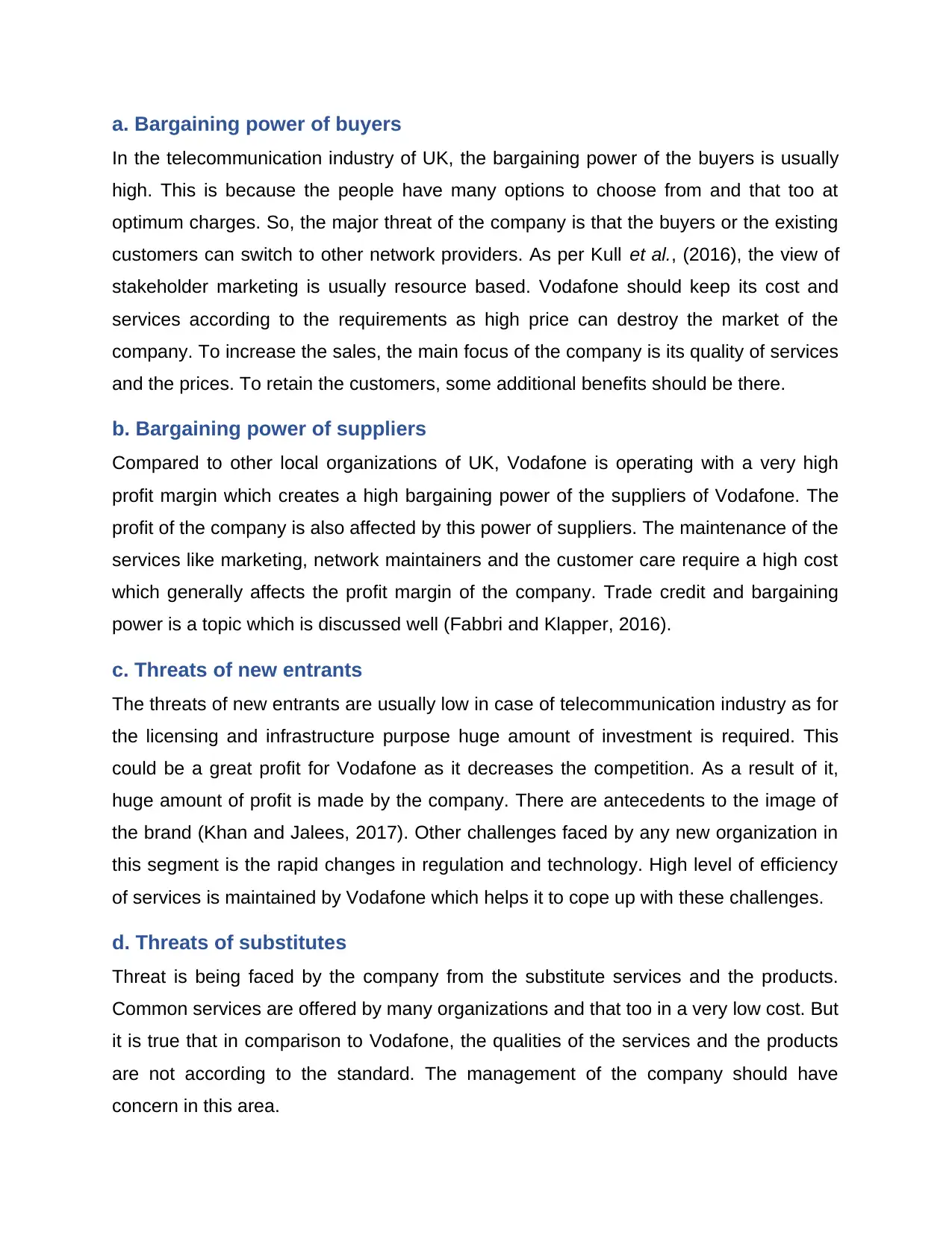
a. Bargaining power of buyers
In the telecommunication industry of UK, the bargaining power of the buyers is usually
high. This is because the people have many options to choose from and that too at
optimum charges. So, the major threat of the company is that the buyers or the existing
customers can switch to other network providers. As per Kull et al., (2016), the view of
stakeholder marketing is usually resource based. Vodafone should keep its cost and
services according to the requirements as high price can destroy the market of the
company. To increase the sales, the main focus of the company is its quality of services
and the prices. To retain the customers, some additional benefits should be there.
b. Bargaining power of suppliers
Compared to other local organizations of UK, Vodafone is operating with a very high
profit margin which creates a high bargaining power of the suppliers of Vodafone. The
profit of the company is also affected by this power of suppliers. The maintenance of the
services like marketing, network maintainers and the customer care require a high cost
which generally affects the profit margin of the company. Trade credit and bargaining
power is a topic which is discussed well (Fabbri and Klapper, 2016).
c. Threats of new entrants
The threats of new entrants are usually low in case of telecommunication industry as for
the licensing and infrastructure purpose huge amount of investment is required. This
could be a great profit for Vodafone as it decreases the competition. As a result of it,
huge amount of profit is made by the company. There are antecedents to the image of
the brand (Khan and Jalees, 2017). Other challenges faced by any new organization in
this segment is the rapid changes in regulation and technology. High level of efficiency
of services is maintained by Vodafone which helps it to cope up with these challenges.
d. Threats of substitutes
Threat is being faced by the company from the substitute services and the products.
Common services are offered by many organizations and that too in a very low cost. But
it is true that in comparison to Vodafone, the qualities of the services and the products
are not according to the standard. The management of the company should have
concern in this area.
In the telecommunication industry of UK, the bargaining power of the buyers is usually
high. This is because the people have many options to choose from and that too at
optimum charges. So, the major threat of the company is that the buyers or the existing
customers can switch to other network providers. As per Kull et al., (2016), the view of
stakeholder marketing is usually resource based. Vodafone should keep its cost and
services according to the requirements as high price can destroy the market of the
company. To increase the sales, the main focus of the company is its quality of services
and the prices. To retain the customers, some additional benefits should be there.
b. Bargaining power of suppliers
Compared to other local organizations of UK, Vodafone is operating with a very high
profit margin which creates a high bargaining power of the suppliers of Vodafone. The
profit of the company is also affected by this power of suppliers. The maintenance of the
services like marketing, network maintainers and the customer care require a high cost
which generally affects the profit margin of the company. Trade credit and bargaining
power is a topic which is discussed well (Fabbri and Klapper, 2016).
c. Threats of new entrants
The threats of new entrants are usually low in case of telecommunication industry as for
the licensing and infrastructure purpose huge amount of investment is required. This
could be a great profit for Vodafone as it decreases the competition. As a result of it,
huge amount of profit is made by the company. There are antecedents to the image of
the brand (Khan and Jalees, 2017). Other challenges faced by any new organization in
this segment is the rapid changes in regulation and technology. High level of efficiency
of services is maintained by Vodafone which helps it to cope up with these challenges.
d. Threats of substitutes
Threat is being faced by the company from the substitute services and the products.
Common services are offered by many organizations and that too in a very low cost. But
it is true that in comparison to Vodafone, the qualities of the services and the products
are not according to the standard. The management of the company should have
concern in this area.
Secure Best Marks with AI Grader
Need help grading? Try our AI Grader for instant feedback on your assignments.
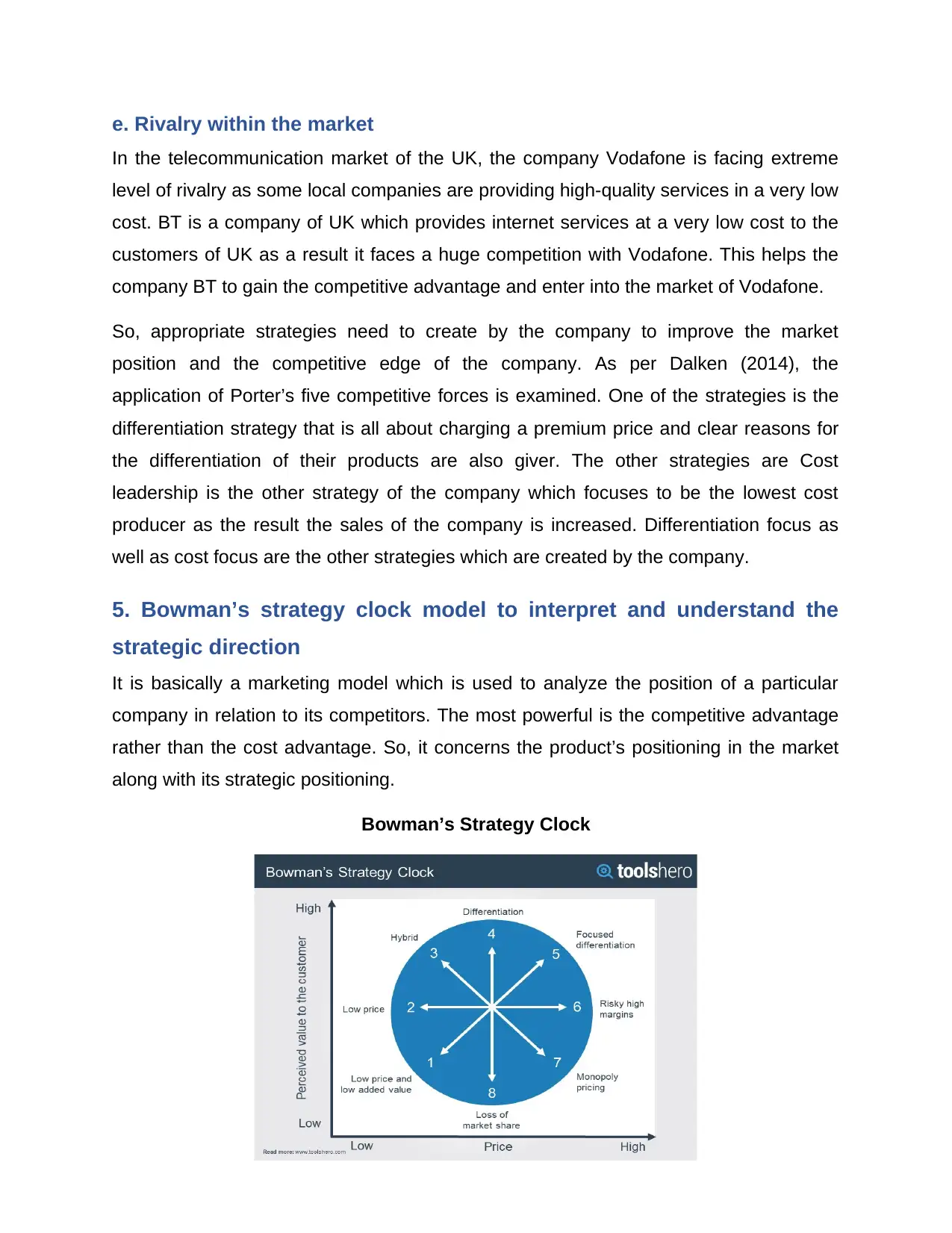
e. Rivalry within the market
In the telecommunication market of the UK, the company Vodafone is facing extreme
level of rivalry as some local companies are providing high-quality services in a very low
cost. BT is a company of UK which provides internet services at a very low cost to the
customers of UK as a result it faces a huge competition with Vodafone. This helps the
company BT to gain the competitive advantage and enter into the market of Vodafone.
So, appropriate strategies need to create by the company to improve the market
position and the competitive edge of the company. As per Dalken (2014), the
application of Porter’s five competitive forces is examined. One of the strategies is the
differentiation strategy that is all about charging a premium price and clear reasons for
the differentiation of their products are also giver. The other strategies are Cost
leadership is the other strategy of the company which focuses to be the lowest cost
producer as the result the sales of the company is increased. Differentiation focus as
well as cost focus are the other strategies which are created by the company.
5. Bowman’s strategy clock model to interpret and understand the
strategic direction
It is basically a marketing model which is used to analyze the position of a particular
company in relation to its competitors. The most powerful is the competitive advantage
rather than the cost advantage. So, it concerns the product’s positioning in the market
along with its strategic positioning.
Bowman’s Strategy Clock
In the telecommunication market of the UK, the company Vodafone is facing extreme
level of rivalry as some local companies are providing high-quality services in a very low
cost. BT is a company of UK which provides internet services at a very low cost to the
customers of UK as a result it faces a huge competition with Vodafone. This helps the
company BT to gain the competitive advantage and enter into the market of Vodafone.
So, appropriate strategies need to create by the company to improve the market
position and the competitive edge of the company. As per Dalken (2014), the
application of Porter’s five competitive forces is examined. One of the strategies is the
differentiation strategy that is all about charging a premium price and clear reasons for
the differentiation of their products are also giver. The other strategies are Cost
leadership is the other strategy of the company which focuses to be the lowest cost
producer as the result the sales of the company is increased. Differentiation focus as
well as cost focus are the other strategies which are created by the company.
5. Bowman’s strategy clock model to interpret and understand the
strategic direction
It is basically a marketing model which is used to analyze the position of a particular
company in relation to its competitors. The most powerful is the competitive advantage
rather than the cost advantage. So, it concerns the product’s positioning in the market
along with its strategic positioning.
Bowman’s Strategy Clock
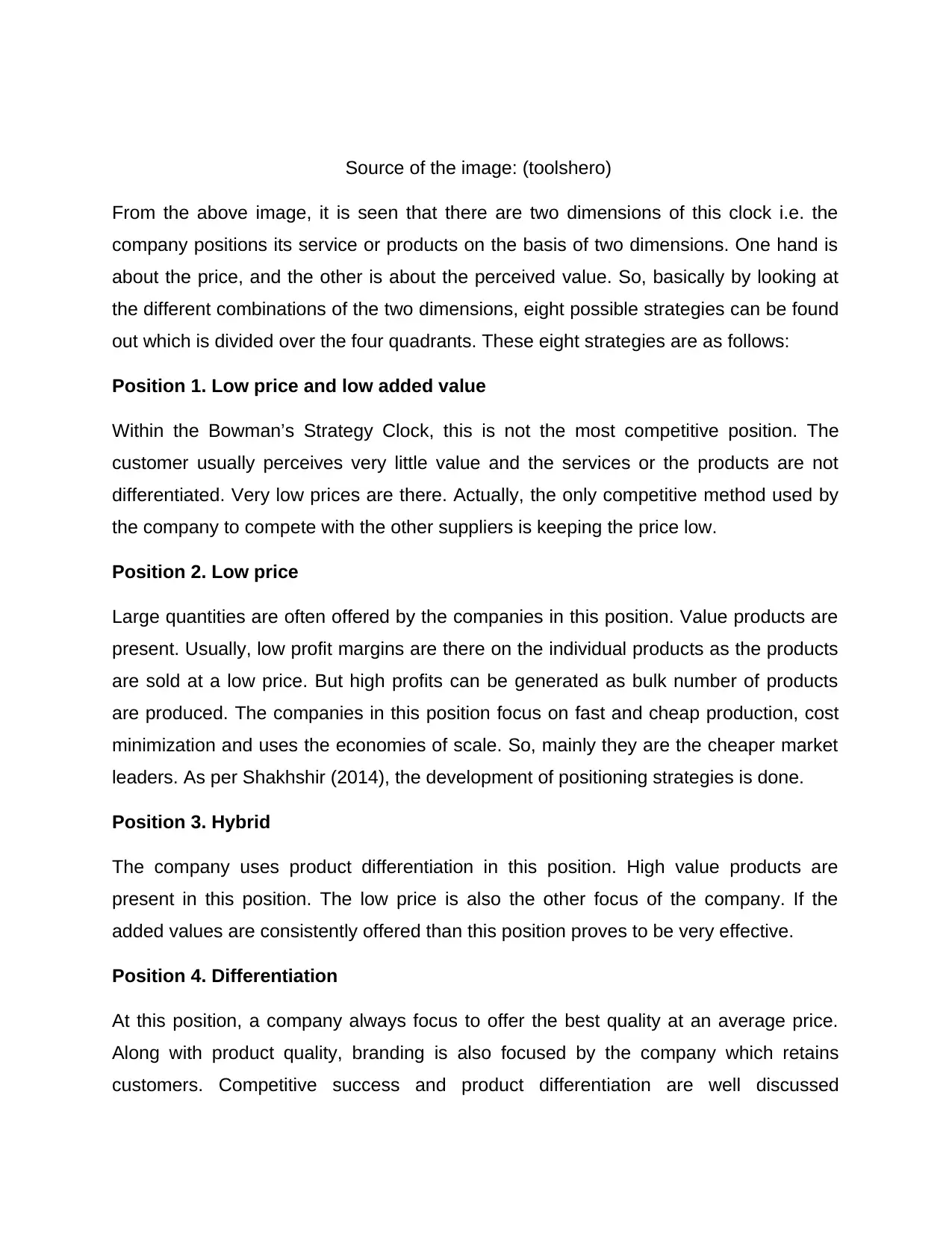
Source of the image: (toolshero)
From the above image, it is seen that there are two dimensions of this clock i.e. the
company positions its service or products on the basis of two dimensions. One hand is
about the price, and the other is about the perceived value. So, basically by looking at
the different combinations of the two dimensions, eight possible strategies can be found
out which is divided over the four quadrants. These eight strategies are as follows:
Position 1. Low price and low added value
Within the Bowman’s Strategy Clock, this is not the most competitive position. The
customer usually perceives very little value and the services or the products are not
differentiated. Very low prices are there. Actually, the only competitive method used by
the company to compete with the other suppliers is keeping the price low.
Position 2. Low price
Large quantities are often offered by the companies in this position. Value products are
present. Usually, low profit margins are there on the individual products as the products
are sold at a low price. But high profits can be generated as bulk number of products
are produced. The companies in this position focus on fast and cheap production, cost
minimization and uses the economies of scale. So, mainly they are the cheaper market
leaders. As per Shakhshir (2014), the development of positioning strategies is done.
Position 3. Hybrid
The company uses product differentiation in this position. High value products are
present in this position. The low price is also the other focus of the company. If the
added values are consistently offered than this position proves to be very effective.
Position 4. Differentiation
At this position, a company always focus to offer the best quality at an average price.
Along with product quality, branding is also focused by the company which retains
customers. Competitive success and product differentiation are well discussed
From the above image, it is seen that there are two dimensions of this clock i.e. the
company positions its service or products on the basis of two dimensions. One hand is
about the price, and the other is about the perceived value. So, basically by looking at
the different combinations of the two dimensions, eight possible strategies can be found
out which is divided over the four quadrants. These eight strategies are as follows:
Position 1. Low price and low added value
Within the Bowman’s Strategy Clock, this is not the most competitive position. The
customer usually perceives very little value and the services or the products are not
differentiated. Very low prices are there. Actually, the only competitive method used by
the company to compete with the other suppliers is keeping the price low.
Position 2. Low price
Large quantities are often offered by the companies in this position. Value products are
present. Usually, low profit margins are there on the individual products as the products
are sold at a low price. But high profits can be generated as bulk number of products
are produced. The companies in this position focus on fast and cheap production, cost
minimization and uses the economies of scale. So, mainly they are the cheaper market
leaders. As per Shakhshir (2014), the development of positioning strategies is done.
Position 3. Hybrid
The company uses product differentiation in this position. High value products are
present in this position. The low price is also the other focus of the company. If the
added values are consistently offered than this position proves to be very effective.
Position 4. Differentiation
At this position, a company always focus to offer the best quality at an average price.
Along with product quality, branding is also focused by the company which retains
customers. Competitive success and product differentiation are well discussed
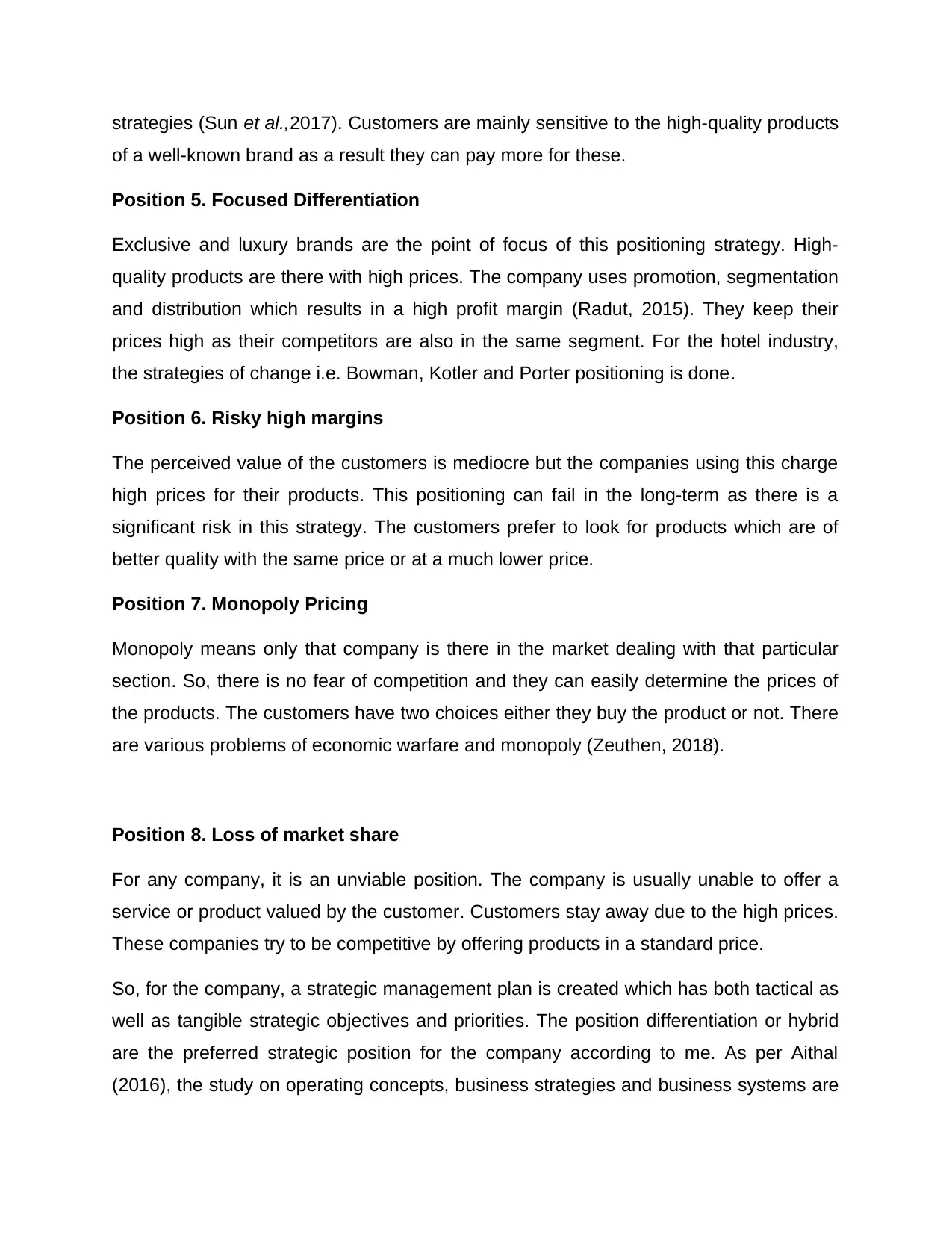
strategies (Sun et al.,2017). Customers are mainly sensitive to the high-quality products
of a well-known brand as a result they can pay more for these.
Position 5. Focused Differentiation
Exclusive and luxury brands are the point of focus of this positioning strategy. High-
quality products are there with high prices. The company uses promotion, segmentation
and distribution which results in a high profit margin (Radut, 2015). They keep their
prices high as their competitors are also in the same segment. For the hotel industry,
the strategies of change i.e. Bowman, Kotler and Porter positioning is done.
Position 6. Risky high margins
The perceived value of the customers is mediocre but the companies using this charge
high prices for their products. This positioning can fail in the long-term as there is a
significant risk in this strategy. The customers prefer to look for products which are of
better quality with the same price or at a much lower price.
Position 7. Monopoly Pricing
Monopoly means only that company is there in the market dealing with that particular
section. So, there is no fear of competition and they can easily determine the prices of
the products. The customers have two choices either they buy the product or not. There
are various problems of economic warfare and monopoly (Zeuthen, 2018).
Position 8. Loss of market share
For any company, it is an unviable position. The company is usually unable to offer a
service or product valued by the customer. Customers stay away due to the high prices.
These companies try to be competitive by offering products in a standard price.
So, for the company, a strategic management plan is created which has both tactical as
well as tangible strategic objectives and priorities. The position differentiation or hybrid
are the preferred strategic position for the company according to me. As per Aithal
(2016), the study on operating concepts, business strategies and business systems are
of a well-known brand as a result they can pay more for these.
Position 5. Focused Differentiation
Exclusive and luxury brands are the point of focus of this positioning strategy. High-
quality products are there with high prices. The company uses promotion, segmentation
and distribution which results in a high profit margin (Radut, 2015). They keep their
prices high as their competitors are also in the same segment. For the hotel industry,
the strategies of change i.e. Bowman, Kotler and Porter positioning is done.
Position 6. Risky high margins
The perceived value of the customers is mediocre but the companies using this charge
high prices for their products. This positioning can fail in the long-term as there is a
significant risk in this strategy. The customers prefer to look for products which are of
better quality with the same price or at a much lower price.
Position 7. Monopoly Pricing
Monopoly means only that company is there in the market dealing with that particular
section. So, there is no fear of competition and they can easily determine the prices of
the products. The customers have two choices either they buy the product or not. There
are various problems of economic warfare and monopoly (Zeuthen, 2018).
Position 8. Loss of market share
For any company, it is an unviable position. The company is usually unable to offer a
service or product valued by the customer. Customers stay away due to the high prices.
These companies try to be competitive by offering products in a standard price.
So, for the company, a strategic management plan is created which has both tactical as
well as tangible strategic objectives and priorities. The position differentiation or hybrid
are the preferred strategic position for the company according to me. As per Aithal
(2016), the study on operating concepts, business strategies and business systems are
Paraphrase This Document
Need a fresh take? Get an instant paraphrase of this document with our AI Paraphraser

done. High-quality products and average prices are the strategies which the company
needs to follow. These are the objectives and tactical actions of Vodafone UK.
needs to follow. These are the objectives and tactical actions of Vodafone UK.
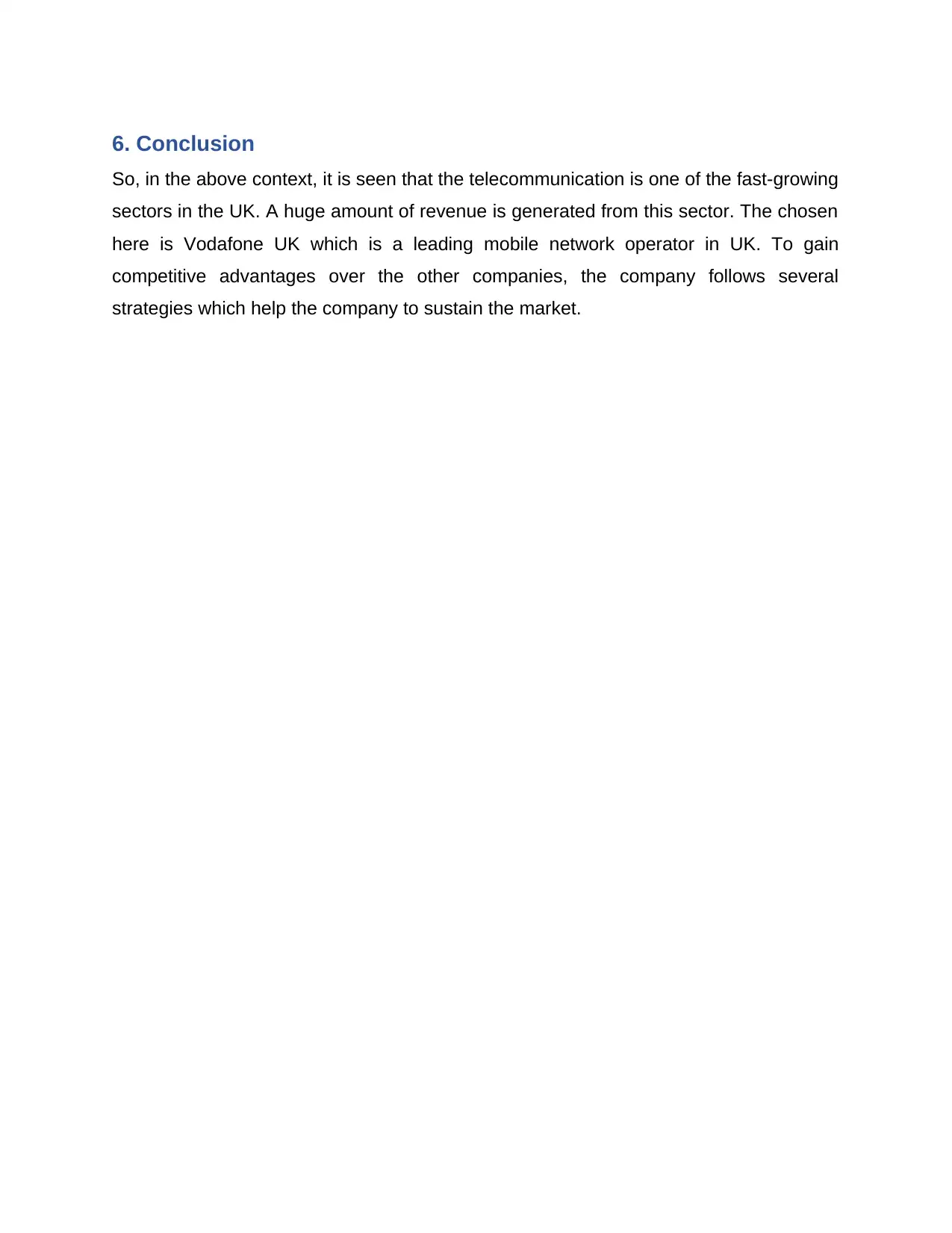
6. Conclusion
So, in the above context, it is seen that the telecommunication is one of the fast-growing
sectors in the UK. A huge amount of revenue is generated from this sector. The chosen
here is Vodafone UK which is a leading mobile network operator in UK. To gain
competitive advantages over the other companies, the company follows several
strategies which help the company to sustain the market.
So, in the above context, it is seen that the telecommunication is one of the fast-growing
sectors in the UK. A huge amount of revenue is generated from this sector. The chosen
here is Vodafone UK which is a leading mobile network operator in UK. To gain
competitive advantages over the other companies, the company follows several
strategies which help the company to sustain the market.
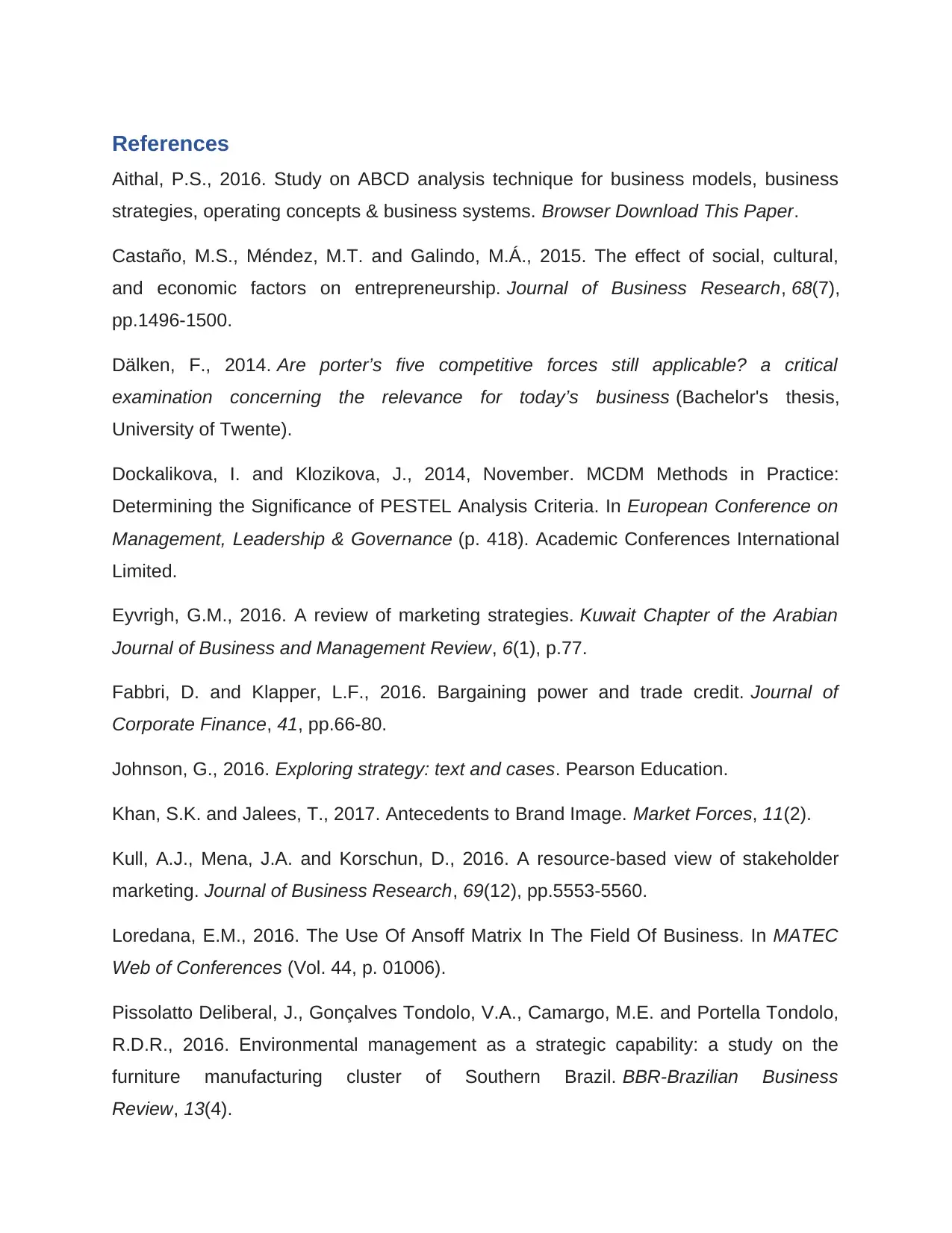
References
Aithal, P.S., 2016. Study on ABCD analysis technique for business models, business
strategies, operating concepts & business systems. Browser Download This Paper.
Castaño, M.S., Méndez, M.T. and Galindo, M.Á., 2015. The effect of social, cultural,
and economic factors on entrepreneurship. Journal of Business Research, 68(7),
pp.1496-1500.
Dälken, F., 2014. Are porter’s five competitive forces still applicable? a critical
examination concerning the relevance for today’s business (Bachelor's thesis,
University of Twente).
Dockalikova, I. and Klozikova, J., 2014, November. MCDM Methods in Practice:
Determining the Significance of PESTEL Analysis Criteria. In European Conference on
Management, Leadership & Governance (p. 418). Academic Conferences International
Limited.
Eyvrigh, G.M., 2016. A review of marketing strategies. Kuwait Chapter of the Arabian
Journal of Business and Management Review, 6(1), p.77.
Fabbri, D. and Klapper, L.F., 2016. Bargaining power and trade credit. Journal of
Corporate Finance, 41, pp.66-80.
Johnson, G., 2016. Exploring strategy: text and cases. Pearson Education.
Khan, S.K. and Jalees, T., 2017. Antecedents to Brand Image. Market Forces, 11(2).
Kull, A.J., Mena, J.A. and Korschun, D., 2016. A resource-based view of stakeholder
marketing. Journal of Business Research, 69(12), pp.5553-5560.
Loredana, E.M., 2016. The Use Of Ansoff Matrix In The Field Of Business. In MATEC
Web of Conferences (Vol. 44, p. 01006).
Pissolatto Deliberal, J., Gonçalves Tondolo, V.A., Camargo, M.E. and Portella Tondolo,
R.D.R., 2016. Environmental management as a strategic capability: a study on the
furniture manufacturing cluster of Southern Brazil. BBR-Brazilian Business
Review, 13(4).
Aithal, P.S., 2016. Study on ABCD analysis technique for business models, business
strategies, operating concepts & business systems. Browser Download This Paper.
Castaño, M.S., Méndez, M.T. and Galindo, M.Á., 2015. The effect of social, cultural,
and economic factors on entrepreneurship. Journal of Business Research, 68(7),
pp.1496-1500.
Dälken, F., 2014. Are porter’s five competitive forces still applicable? a critical
examination concerning the relevance for today’s business (Bachelor's thesis,
University of Twente).
Dockalikova, I. and Klozikova, J., 2014, November. MCDM Methods in Practice:
Determining the Significance of PESTEL Analysis Criteria. In European Conference on
Management, Leadership & Governance (p. 418). Academic Conferences International
Limited.
Eyvrigh, G.M., 2016. A review of marketing strategies. Kuwait Chapter of the Arabian
Journal of Business and Management Review, 6(1), p.77.
Fabbri, D. and Klapper, L.F., 2016. Bargaining power and trade credit. Journal of
Corporate Finance, 41, pp.66-80.
Johnson, G., 2016. Exploring strategy: text and cases. Pearson Education.
Khan, S.K. and Jalees, T., 2017. Antecedents to Brand Image. Market Forces, 11(2).
Kull, A.J., Mena, J.A. and Korschun, D., 2016. A resource-based view of stakeholder
marketing. Journal of Business Research, 69(12), pp.5553-5560.
Loredana, E.M., 2016. The Use Of Ansoff Matrix In The Field Of Business. In MATEC
Web of Conferences (Vol. 44, p. 01006).
Pissolatto Deliberal, J., Gonçalves Tondolo, V.A., Camargo, M.E. and Portella Tondolo,
R.D.R., 2016. Environmental management as a strategic capability: a study on the
furniture manufacturing cluster of Southern Brazil. BBR-Brazilian Business
Review, 13(4).
Secure Best Marks with AI Grader
Need help grading? Try our AI Grader for instant feedback on your assignments.
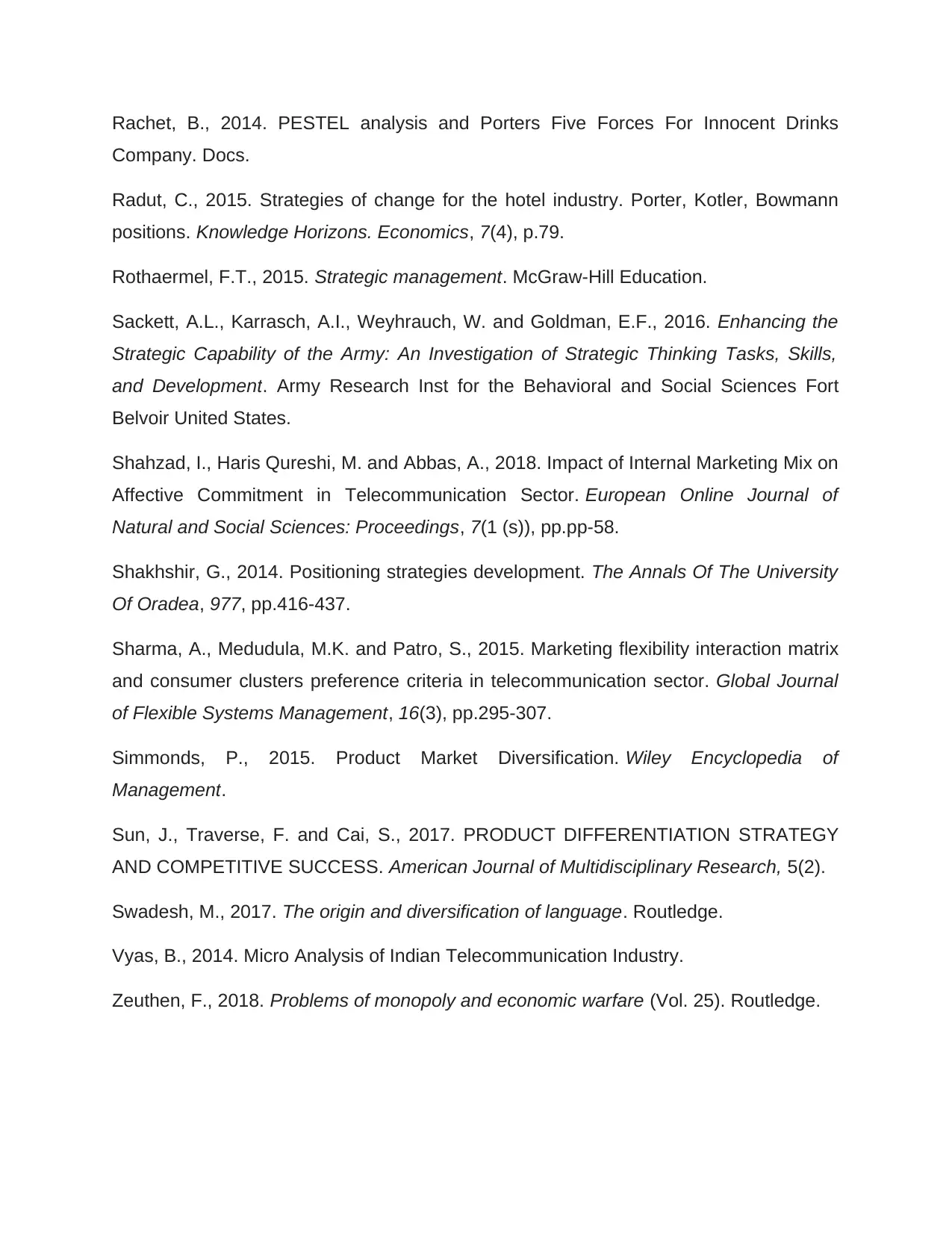
Rachet, B., 2014. PESTEL analysis and Porters Five Forces For Innocent Drinks
Company. Docs.
Radut, C., 2015. Strategies of change for the hotel industry. Porter, Kotler, Bowmann
positions. Knowledge Horizons. Economics, 7(4), p.79.
Rothaermel, F.T., 2015. Strategic management. McGraw-Hill Education.
Sackett, A.L., Karrasch, A.I., Weyhrauch, W. and Goldman, E.F., 2016. Enhancing the
Strategic Capability of the Army: An Investigation of Strategic Thinking Tasks, Skills,
and Development. Army Research Inst for the Behavioral and Social Sciences Fort
Belvoir United States.
Shahzad, I., Haris Qureshi, M. and Abbas, A., 2018. Impact of Internal Marketing Mix on
Affective Commitment in Telecommunication Sector. European Online Journal of
Natural and Social Sciences: Proceedings, 7(1 (s)), pp.pp-58.
Shakhshir, G., 2014. Positioning strategies development. The Annals Of The University
Of Oradea, 977, pp.416-437.
Sharma, A., Medudula, M.K. and Patro, S., 2015. Marketing flexibility interaction matrix
and consumer clusters preference criteria in telecommunication sector. Global Journal
of Flexible Systems Management, 16(3), pp.295-307.
Simmonds, P., 2015. Product Market Diversification. Wiley Encyclopedia of
Management.
Sun, J., Traverse, F. and Cai, S., 2017. PRODUCT DIFFERENTIATION STRATEGY
AND COMPETITIVE SUCCESS. American Journal of Multidisciplinary Research, 5(2).
Swadesh, M., 2017. The origin and diversification of language. Routledge.
Vyas, B., 2014. Micro Analysis of Indian Telecommunication Industry.
Zeuthen, F., 2018. Problems of monopoly and economic warfare (Vol. 25). Routledge.
Company. Docs.
Radut, C., 2015. Strategies of change for the hotel industry. Porter, Kotler, Bowmann
positions. Knowledge Horizons. Economics, 7(4), p.79.
Rothaermel, F.T., 2015. Strategic management. McGraw-Hill Education.
Sackett, A.L., Karrasch, A.I., Weyhrauch, W. and Goldman, E.F., 2016. Enhancing the
Strategic Capability of the Army: An Investigation of Strategic Thinking Tasks, Skills,
and Development. Army Research Inst for the Behavioral and Social Sciences Fort
Belvoir United States.
Shahzad, I., Haris Qureshi, M. and Abbas, A., 2018. Impact of Internal Marketing Mix on
Affective Commitment in Telecommunication Sector. European Online Journal of
Natural and Social Sciences: Proceedings, 7(1 (s)), pp.pp-58.
Shakhshir, G., 2014. Positioning strategies development. The Annals Of The University
Of Oradea, 977, pp.416-437.
Sharma, A., Medudula, M.K. and Patro, S., 2015. Marketing flexibility interaction matrix
and consumer clusters preference criteria in telecommunication sector. Global Journal
of Flexible Systems Management, 16(3), pp.295-307.
Simmonds, P., 2015. Product Market Diversification. Wiley Encyclopedia of
Management.
Sun, J., Traverse, F. and Cai, S., 2017. PRODUCT DIFFERENTIATION STRATEGY
AND COMPETITIVE SUCCESS. American Journal of Multidisciplinary Research, 5(2).
Swadesh, M., 2017. The origin and diversification of language. Routledge.
Vyas, B., 2014. Micro Analysis of Indian Telecommunication Industry.
Zeuthen, F., 2018. Problems of monopoly and economic warfare (Vol. 25). Routledge.
1 out of 17
Related Documents
Your All-in-One AI-Powered Toolkit for Academic Success.
+13062052269
info@desklib.com
Available 24*7 on WhatsApp / Email
![[object Object]](/_next/static/media/star-bottom.7253800d.svg)
Unlock your academic potential
© 2024 | Zucol Services PVT LTD | All rights reserved.





